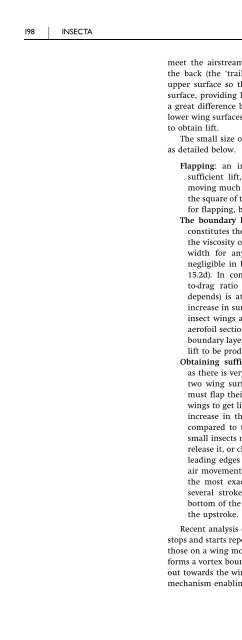An Introduction to the Invertebrates, Second Edition - tiera.ru
An Introduction to the Invertebrates, Second Edition - tiera.ru
An Introduction to the Invertebrates, Second Edition - tiera.ru
Create successful ePaper yourself
Turn your PDF publications into a flip-book with our unique Google optimized e-Paper software.
198 INSECTAmeet <strong>the</strong> airstream over <strong>the</strong> upper surface. A vortex is set up at<strong>the</strong> back (<strong>the</strong> ‘trailing edge’), pulling <strong>to</strong>wards it <strong>the</strong> air over <strong>the</strong>upper surface so that it moves faster than <strong>the</strong> air over <strong>the</strong> lowersurface, providing lift. A large bird can glide: a large wing providesa great difference between <strong>the</strong> rates of air flow over <strong>the</strong> upper andlower wing surfaces. In large flying animals, flapping is not essential<strong>to</strong> obtain lift.The small size of insects demands a ra<strong>the</strong>r different mechanism,as detailed below.Flapping: an insect, like a small bird, must flap <strong>to</strong> obtainsufficient lift, by increasing <strong>the</strong> rate of air flow over wingsmoving much faster than <strong>the</strong> main body (lift is proportional <strong>to</strong><strong>the</strong> square of <strong>the</strong> velocity). The small size of insects is favourablefor flapping, because <strong>the</strong> power-<strong>to</strong>-weight ratio is high.The boundary layer of inert air sticking <strong>to</strong> <strong>the</strong> wing surfacesconstitutes <strong>the</strong> greatest problem for a very small flier. Owing <strong>to</strong><strong>the</strong> viscosity of air any wing has a boundary layer, of <strong>the</strong> samewidth for any size of wing: a boundary layer of 1 mm isnegligible in birds, but relatively enormous in insects (Figure15.2d). In consequence of this large ‘viscous drag’, <strong>the</strong> lift<strong>to</strong>-dragratio (on which <strong>the</strong> speed and efficiency of flightdepends) is at best only about a tenth of that in birds. <strong>An</strong>yincrease in surface area increases viscous drag, and accordinglyinsect wings are flat plates, not aerofoil sections. However, anaerofoil section is produced when a flat plate with an adheringboundary layer is moved through <strong>the</strong> air, and this shape enableslift <strong>to</strong> be produced.Obtaining sufficient lift remains difficult for a very small flier,as <strong>the</strong>re is very little difference between air flow rates over <strong>the</strong>two wing surfaces, and <strong>to</strong> obtain sufficient lift small insectsmust flap <strong>the</strong>ir wings very fast indeed. Many insects turn <strong>the</strong>irwings <strong>to</strong> get lift on <strong>the</strong> upstroke as well as <strong>the</strong> downstroke. <strong>An</strong>yincrease in <strong>the</strong> rate of air movement over <strong>the</strong> upper surfacecompared <strong>to</strong> <strong>the</strong> lower surface will increase lift: for examplesmall insects may bend <strong>the</strong> wing along its length and suddenlyrelease it, or clap <strong>the</strong> wings <strong>to</strong>ge<strong>the</strong>r dorsally and <strong>the</strong>n fling <strong>the</strong>leading edges apart (Figure 15.2e). Hovering, when <strong>the</strong>re is noair movement provided by <strong>the</strong> whole body moving forward, is<strong>the</strong> most exacting form of flight. Lift is acquired only afterseveral strokes and even <strong>the</strong>n it is only obtained near <strong>the</strong>bot<strong>to</strong>m of <strong>the</strong> downstroke and lost again as <strong>the</strong> wing turns for<strong>the</strong> upstroke.Recent analysis emphasises that <strong>the</strong> forces acting on a wing thats<strong>to</strong>ps and starts repeatedly as it beats up and down are different fromthose on a wing moving at constant speed. Air over <strong>the</strong> leading edgeforms a vortex bound <strong>to</strong> <strong>the</strong> upper surface of <strong>the</strong> wing and spirallingout <strong>to</strong>wards <strong>the</strong> wing tip (Figure 5.2f). This is <strong>the</strong> main aerodynamicmechanism enabling small insects <strong>to</strong> fly.











